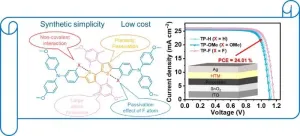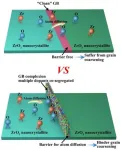(Press-News.org)
Perovskite solar cells (PSCs) are celebrated for their exceptional photovoltaic performance and affordability. However, the high cost of charge transport materials remains a major obstacle to their commercialization. Conventional materials like 2,2',7,7'-Tetrakis[N,N-di(4-methoxyphenyl)amino]-9,9'-spirobifluorene (Spiro-OMeTAD), are expensive and complex to produce. Therefore, developing low-cost, efficient alternatives is essential to make PSCs more economically viable. Addressing these issues is crucial for advancing solar technology and achieving broader adoption. Hence, this study focuses on creating cost-effective hole transport materials to overcome these barriers and enhance the commercial potential of PSCs.
Researchers from Huaqiao University and Qufu Normal University have unveiled a pioneering advancement in the field of solar energy. Their study (DOI: 10.26599/EMD.2024.9370036), published in June 2024 in the esteemed journal Energy Materials and Devices, introduces three novel hole transport materials that could redefine the efficiency of n-i-p PSCs. These materials, meticulously designed and synthesized, exhibit remarkable properties that have the potential to surpass the current benchmarks in solar cell performance, offering a promising step towards the future of renewable energy.
This study presents the development of three cost-effective hole transport materials (HTMs), 4,4'-(3,3'-bis(4-methoxy-2,6-dimethylphenyl)-[2,2'-bithiophene]-5,5'-diyl)bis(N,N-bis(4-methoxyphenyl)aniline) (TP-H), 4,4'-(3,3'-bis(4-methoxy-2,6-dimethylphenyl)-[2,2'-bithiophene]-5, 5'-diyl)bis(3-methoxy-N,N-bis(4-methoxyphenyl)aniline) (TP-OMe), and 4,4'-(3,3'-bis(4-methoxy-2,6-dimethylphenyl)-[2,2'-bithiophene]-5,5'-diyl)bis(3-fluoro-N,N-bis(4-methoxyphenyl)aniline) (TP-F), using a bithiophene core. These materials were designed to enhance molecular crystallinity and solubility, crucial for effective hole transport in PSCs. TP-F, in particular, achieved a power conversion efficiency (PCE) exceeding 24%, attributed to its fluorine atom substitution, which enhanced intermolecular packing, lowered the highest occupied molecular orbital (HOMO) energy level, and improved hole mobility and conductivity. These improvements reduced defect states and minimized trap-mediated recombination in PSCs. The study highlights the potential of the 3,3'-bis(4-methoxy-2,6-dimethylphenyl)-2,2'-bithiophene core structure for creating efficient, low-cost HTMs, demonstrating significant advancements in PSC technology and paving the way for more commercially viable solar energy solutions.
Dr. Wei Gao, a leading researcher in the study, stated, "The development of these novel HTMs marks a significant step towards making PSCs more commercially viable. The enhanced efficiency and reduced costs of these materials could accelerate the adoption of PSCs in the solar energy market, providing a more sustainable and cost-effective energy solution."
The implications of this research are profound, as it opens up new avenues for the commercial production of high-efficiency, low-cost PSCs. The successful integration of TP-F into PSCs demonstrates the potential for these materials to significantly reduce production costs while maintaining high performance. This advancement could lead to broader adoption of solar energy technologies, contributing to global efforts in sustainable energy development and reducing reliance on fossil fuels.
This work was financially supported by the National Natural Science Foundation of China (Grant Nos. U23A20371, U21A2078, and 22179042), the Natural Science Foundation of Fujian Province (Grant No. 2023J06034), the Natural Science Foundation of Xiamen, China (Grant No. 3502Z20227036), and the Scientific Research Funds of Huaqiao University (Grant No. 605-50Y23024).
About Energy Materials and Devices
Energy Materials and Devices is launched by Tsinghua University, published quarterly by Tsinghua University Press, exclusively available via SciOpen, aiming at being an international, single-blind peer-reviewed, open-access and interdisciplinary journal in the cutting-edge field of energy materials and devices. It focuses on the innovation research of the whole chain of basic research, technological innovation, achievement transformation and industrialization in the field of energy materials and devices, and publishes original, leading and forward-looking research results, including but not limited to the materials design, synthesis, integration, assembly and characterization of devices for energy storage and conversion etc.
About SciOpen
SciOpen is an open access resource of scientific and technical content published by Tsinghua University Press and its publishing partners. SciOpen provides end-to-end services across manuscript submission, peer review, content hosting, analytics, identity management, and expert advice to ensure each journal’s development. By digitalizing the publishing process, SciOpen widens the reach, deepens the impact, and accelerates the exchange of ideas.
END
To date, ceramic scientists have devised various strategies to impede grain coarsening. The utilization of nano-sized precursor powder can not only facilitate the densification process, but also yields bulk ceramics with reduced grain sizes compared with micron-sized precursor powder. Rapid sintering by passes the low-temperature surface diffusion stage and directly enters the high-temperature sintering stage through rapid heating, rendering it an effective way to inhibit grain coarsening. However, these aforementioned strategies fail to prevent coarsening during the application of nano-ceramics in medium- ...
The development of innovative medicines is an expensive, time-consuming and risky business. On average, it usually takes at least a decade and billions of dollars to bring a new drug from project initiation to approval. Identifying effective targets and conducting biological analysis is the first step in the process and remains a top priority in drug development.
To facilitate for maximum data privacy and data security, Insilico Medicine ("Insilico"), developed a hardware platform, PandaOmics Box, that does not require Internet access and allows for on-premise biological analytics, target identification, biomarker ...
OAK BROOK, Ill. – The radiology gender gap is decreasing, but there remains work to be done, according to an editorial published today in RadioGraphics, a journal of the Radiological Society of North America (RSNA).
In 2022, nearly half of residents and fellows in Accreditation Council for Graduate Medical Education
(ACGME)–accredited programs were female. However, less than 27% of active diagnostic radiologists and only 10% of active interventional radiologists are female. Within the 48 largest medical specialty groups, diagnostic radiology ranks 41st and ...
NEW YORK, NY– The American Federation for Aging Research (AFAR) is pleased to announce a $450,000 grant from The Hearst Foundations in support of the Grants for Junior Faculty program.
The Grants for Junior Faculty provide early career investigators with up to $150,000 for one to two years to support research focused on aging processes and age-related diseases. The $450,000 grant from Hearst Foundations will fully underwrite three Grants for Junior Faculty over the next three years.
Selected ...
Using two optically trapped glass nanoparticles, researchers observed a novel collective Non-Hermitian and nonlinear dynamic driven by nonreciprocal interactions. This contribution expands traditional optical levitation with tweezer arrays by incorporating the so called non-conservative interactions. Their findings, supported by an analytical model developed by collaborators from Ulm University and the University of Duisburg-Essen, were recently published in Nature Physics.
Fundamental forces like gravity and electromagnetism are reciprocal, meaning two ...
New, non-native plant species are constantly being discovered in Svalbard, and researchers are working to ascertain what threat these species pose to the native plants.
So far, the Arctic has managed to avoid one of the most serious threats to biodiversity on Earth. This is also true for Svalbard, but things could change very quickly, and researchers want to find out how to counteract this threat.
“Increased human activity heightens the risk of new plant species being introduced. And climate change increases the risk of invasive species establishing themselves,” says Kristine Bakke Westergaard.
She is an associate ...
Available to anyone, anywhere, at anytime, Texl.org allows individuals and organizations to create scientifically valid surveys in less than five minutes. In drag-and-drop fashion, survey creators can choose from an ever-growing list of 50 validated scales, measuring aspects ranging from team conflict to personal initiative and transformational leadership.
“The point of science is to develop knowledge that ultimately is to the benefit of society. Unfortunately, we are not always great in translating our knowledge so that it is usable for practitioners out there. With Texl we’re changing that,” explains Professor Niels Van Quaquebeke, ...
While chemotherapy has advanced in personalization, personalized radiation therapy for cancer remains underdeveloped. Current cancer treatment methods – including radiation therapy – are intricate, lack personalization, and rely heavily on the expertise of medical teams. Medical image analysis and machine learning hold great promise for enhancing personalized oncology. However, challenges persist such as limited high-quality data and data complexity.
Wazir Muhammad, Ph.D., principal investigator and ...
HOUSTON and MIAMI ― The University of Texas MD Anderson Cancer Center and Summit Therapeutics, Inc. today announced a strategic five-year collaboration agreement for the purpose of accelerating the development of ivonescimab.
Leveraging MD Anderson’s clinical infrastructure and research expertise together with Summit’s innovative, investigational, potential first-in-class PD-1/VEGF bispecific antibody, the collaboration is designed to quickly discover additional opportunities for ivonescimab, including several tumors outside of its current development plan. MD Anderson will lead multiple clinical trials in several tumor types to evaluate the safety and potential clinical ...
Scientists have known from ice core research that it's easier to melt an ice sheet than to freeze it up again. Now, they know at least part of the reason why, and it has to do with ice's "sponginess," according to a new study published July 24 in The Cryosphere.
The study uses a physics-based numerical model to assess the impacts of warming and cooling on firn, the porous layer between snow and glacial ice, over the entire Greenland Ice Sheet. Megan Thompson-Munson, a CIRES and ATOC PhD student, led the study alongside ...







